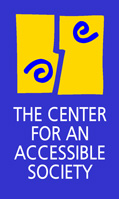
DISABILITY
ISSUES
INFORMATION
FOR
JOURNALISTS
ABOUT
THE CENTER
Website access requirement announcement draws little fire -- or notice
Note to readers: links to news articles may not work after a few weeks, as news media remove current stories to their archives. The link may take you to the archives section, where, for a fee, you can view the article.
Jan. 2, 2001 -- On Dec. 21, the U.S. Access Board announced its long-awaited guidelines that federal agencies must follow to make their websites accessible to people with disabilities. The standards, to ensure compliance with Section 508 of the Rehabilitation Act and the WorkForce Investment Act of 1998, will take effect June 21. An Associated Press story that same day (one version can be found at http://www.nytimes.com/2000/12/22/technology/22DISA.html gave the basics.
Yesterday, The New York Times's Technology section carried a follow-up story which seemed to quote more advocates of access than detractors -- something that has not often happened in media coverage of web access. In his January 1 story, "Advocates of People With Disabilities Take Online Stores to Task," (online at http://www.nytimes.com/2001/01/01/technology/01ECOMMERCE.html Times technology reporter Bob Tedeschi quoted The National Federation of the Blind's James Gashel, who told Tedeschi that 300,000 to 400,000 blind people commonly relied on "screen reader" software.
"Advocates for people with disabilities say they have been essentially shut out by as many as half of all Internet stores," wrote Tedeschi. "The things that need to be done to make a site accessible are not that hard to do, but they get ignored until somebody raises a stink," Jane Jarrow said. Jarrow was identified as "president of Disability Access Information and Support, a consulting firm."
A review of major newspapers suggests that the usual access detractors haven't begun to yell about this latest round of web access yet; other than the stories mentioned above, there was little coverage of the new guidelines. That can be expected to change, though, as anti-regulatory interests wind up for their potshots at access.
A story by PC World reporter Judy Heim on how web access works -- or should work -- is still one of the best primers we've found. From the Sept. 2000 issue, it's online at http://www.pcworld.com/features/article.asp?aid=17690
The Access Board's own overview, and the guidelines themselves, can be found at http://www.access-board.gov/news/508-final.htm